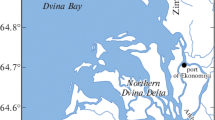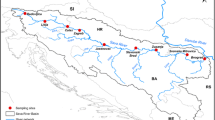Abstract
The results of continuous four-year-long investigations (from May 2015 to April 2019) of the elemental composition of water and suspended matter in the Northern Dvina River are given. Water was sampled every month at two sites in the lower reaches of the river. More than 50 major and trace elements are determined in water filtered through Nuclepore filters and in suspended matter on the filters. The methods of inductively coupled plasma mass spectrometry and atomic absorption spectrophotometry were used. In contrast to most similar publications previously, the mean concentrations of elements weighted to water discharge (dissolved forms) and to suspended matter discharge (suspended forms) are obtained, which enables us to consider them as the closest to reality. Comparison with the mean concentrations in world rivers shows that the Corg and Fe concentrations in the water of the Northern Dvina River exceed them by 3–5 times. This is related to natural factors, primarily to specific features of the catchment basin (widely spread bogs). The presence or absence of correlation between trace elements and organoferric colloids significantly affects their concentration. The content of elements in the suspended matter of the river is similar to the mean global level, except for Corg and P. We calculate the discharges of dissolved and suspended elements for every year of research and the mean for the four-year period.







Similar content being viewed by others

REFERENCES
Yu. V. Alekhin, S. M. Il’ina, S. A. Lapitskii, et al., “Specific behavior of rare earth elements in the river discharge of the boreal climatic zone,” Byull. Mosk. O-va. Ispyt. Prir., Otd. Geol. 87 (3), 33–42 (2012).
V. V. Gordeev, River Runoff in Ocean and its Main Geochemical Features (Nauka, Moscow, 1983) [in Russian].
V. V. Gordeev, A. S. Filippov, M. V. Kravchishina, et al., “Specific geochemistry of river run-off to the White Sea,” in The White Sea System, Vol. 2: Water Column and Interacting Atmosphere, Cryosphere, River Run-Off, and Biosphere (Nauchnyi Mir, Moscow, 2012), pp. 225–308.
V. V. Gordeev and V. P. Shevchenko, “Forms of some metals in the suspended sediments of the Northern Dvina River and their seasonal variations,” Oceanology (Engl. Transl.) 52, 261–270 (2012).
V. V. Gordeev, O. M. Dara, T. N. Alekseeva, et al., “Seasonal variations in the grain size distribution and mineral composition of suspended particulate matter of the Northern Dvina River,” Oceanology (Engl. Transl.) 60, 384–392 (2020).
V. V. Gordeev, A. I. Kochenkova, A. S. Lokhov, et al., “Seasonal and inter annual variations between concentrations and fluxes of dissolved and particulate organic carbon, iron and manganese from the Northern Dvina River to the White Sea,” Oceanology (Engl. Transl.) 61, 34–47 (2021).
V. V. Ivanov and V. A. Bryzgalo, “Hydrological-hydrochemical regime of the White Sea watershed,” in The White Sea and Its Watershed Affected by Climate and Anthropogenic Factors, Ed. by N. N. Filatov and A. Yu. Terzhevik (Karelian Scientific Center, Russian Academy of Sciences, Petrozavodsk, 2007), pp. 119–145.
G. S. Konovalov, “Transfer of trace elements by the main rivers in the USSR,” Dokl. Akad. Nauk SSSR 129, 912–915 (1959).
G. S. Konovalov, A. A. Ivanova, and T. Kh. Kolesnikova, “Scattered and rare elements dissolved in water and included into suspended matter of main rivers of the USSR,” Geochemistry of Sedimentary Minerals and Ores (Nauka, Moscow, 1968), pp. 72–87.
M. D. Kravchishina, V. P. Shevchenko, A. S. Filippov, et al., “Composition of the suspended particulate matter at the Severnaya Dvina River mouth (White Sea) during the spring flood period,” Oceanology (Engl. Transl.) 50, 365–385 (2010).
V. N. Mikhailov, River Mouths of Russia and Adjacent Countries: Past, Present, Future (GEOS, Moscow, 1997) [in Russian].
N. P. Morozov, G. N. Baturin, V. V. Gordeev, and E. G. Gurvich, “Composition of suspended matter and sediments in estuarine areas of the Severnaya Dvina, Mezen’, Pechora, Ob’ rivers,” Gidrokhim. Mater. 60, 60–73 (1974).
I. A. Nemirovskaya, A. I. Kochenkova, and A. V. Khramtsova, “Hydrocarbons at the geochemical barrier Northern Dvina–White Sea,” Okeanologiya (Moscow) 60, 281–290 (2020).
A. E. Ovsepyan and Yu. A. Fedorov, Mercury in the Estuary Area of the Northern Dvina River (Rosizdat, Rostov-on-Don, 2011) [in Russian].
V. S. Savenko, Chemical composition of the World River’s Suspended Matter (GEOS, Moscow, 2006) [in Russian].
A. V. Savenko, N. A. Demidenko, and O. S. Pokrovskii, “Chemical transformation of the runoff of dissolved matters in the mouth areas of the Onega and Mezen’ rivers,” Geochem. Int. 54, 439–448 (2016).
A. V. Savenko, V. S. Savenko, and O. S. Pokrovsky, “New data on the concentrations of dissolved trace elements in waters of Russian Arctic rivers,” Dokl. Earth Sci. 491, 257–263 (2020).
V. P. Shevchenko, A. S. Filippov, A. Yu. Bogunov, et al., “Geochemical studies of suspended matter in the marginal filter of the Northern Dvina River at the end of winter,” Vestn. Arkhangel’sk. Gos. Tekh. Univ., Ser. Prikl. Geoekol., No. 70, 164–176 (2007).
V. P. Shevchenko, O. S. Pokrovsky, A. S. Filippov, et al., “On the elemental composition of suspended matter of the Severnaya Dvina River (White Sea region),” Dokl. Earth Sci. 430, 228–234 (2010).
A. A. Chupakova, A. V. Chupakov, N. V. Neverova, et al., “Photodegradation of dissolved organic matter and trace metals in the largest European Arctic estuary,” Sci. Total Environ. 622–623, 1343–1352 (2018).
A. V. Chupakov, O. S. Pokrovsky, O. Y. Moreva, et al., “High resolution multi-annual riverine fluxes of organic carbon, nutrient and trace element from the large European Arctic river, Severnaya Dvina,” Chem. Geol. 538, 119491 (2020).
J. Gaillardet, J. Viers, and B. Dupre, “Trace elements in river waters,” in Treasure of Geochemistry, Ed. by H. D. Holland, K. K. Turekian, and J. L. Drever (Elsevier, Amsterdam, 1994), Vol. 5, pp. 225–272.
V. V. Gordeev and M. D. Kravchishina, “River flux of dissolved organic carbon (DOC) and particulate organic carbon (POC) to the Arctic Ocean: what are the consequences of the global changes,” in Influence of Climate Change on the Changing Arctic and Sub-Arctic Conditions, Ed. by J. C. J. Nihoul and A. G. Kostianoy (Springer-Verlag, Dordrecht, 2009), pp. 145–160.
V. V. Gordeev, O. S. Pokrovsky, and V. P. Shevchenko, “The geochemical features of the river discharge to the White Sea,” in Biogeochemistry of the Atmosphere, Ice and Water of the White Sea: The White Sea Environment, Ed. by A. P. Lisitsyn and V. V. Gordeev (Springer-Verlag, Cham, 2018), Part 1, pp. 47–82.
V. V. Gordeev, O. S. Pokrovsky, and V. P. Shevchenko, “The mixing zone between waters of the Severnaya Dvina River and the White Sea,” in Biogeochemistry of the Atmosphere, Ice and Water of the White Sea: The White Sea Environment, Ed. by A. P. Lisitsyn and V. V. Gordeev (Springer-Verlag, Cham, 2018), Part 1, pp. 83–114.
B. Hwang, Y. Aksenov, E. Blacklay, et al., “Impact of climate change on the Arctic ice decline,” MCCIP Sci. Rev. 2020, 208–226 (2020).
A. D. McGuire, F. S. Chapin III, J. E. Walsh, and C. Wirth, “Integrated regional changes in arctic climate feedbacks: implications for the Global Climate System,” Annu. Rev. Environ. Resour. 31, 61–91 (2006).
J. W. McClelland, S. J. Dery, B. J. Peterson, et al., “A pan-arctic evaluation of changes in river discharge during the latter half of the 20-th century,” Geophys. Res. Lett. 33, (2006).https://doi.org/10.1029/2006GL025753
M. Meybeck, “Carbon, nitrogen and phosphorus transport by world rivers,” Am. J. Sci. 282, 401–450 (1982).
H. Pack, E. Watanabe, Y. Kim, et al., “Increasing riverine heat influx triggers Arctic sea ice decine and oceanic and atmospheric warming,” Sci. Adv. 6, eabc4699 (2020).
O. S. Pokrovsky, J. Viers, L. S. Shirokova, et al., “Dissolved, suspended and colloidal fluxes of organic carbon, major and trace elements in the Severnaya Dvina River and its tributary,” Chem. Geol. 273, 136–149 (2010).
O. S. Pokrovsky, J. Viers, B. Dupre, et al., “Biogeochemistry of carbon, major and trace elements in watersheds of northern Eurasia drained to the Arctic Ocean: The change of fluxes, sources and mechanisms under the climate warming prospective,” C. R. Geosci. 344 (11–12), 663–677 (2012).
O. S. Pokrovsky, L. S. Shirokova, J. Viers, et al., “Fate of colloids during estuarine mixing in the Arctic,” Ocean Sci. 10, 107–128 (2014).
O. S. Pokrovsky, J. Viers, A. V. Chupakov, et al., “Trace elements in the form of organo-mineral colloids in the mixing zone of the Arctic Rivers,” in Biogeochemistry of Trace Elements, Ed. by O. S. Pokrovsky and J. Viers (Nova Science, New York, 2018), pp. 245–288.
M. C. Serezze, J. E. Walsh, F. S. Chapin III, et al., “Observational evidence of change in the northern high-latitude environment,” Clim. Change 46, 159–207 (2006).
L. S. Shirokova, A. A. Chupakova, A. V. Chupakov, and O. S. Pokrovsky, “Transformation of dissolved organic matter and related trace element in the mouth zone of the largest European Arctic river: experimental modeling,” Inland Waters. 7 (3), 272–282 (2017).
E. R. Sholkovitz, “The aquatic chemistry of rare earth elements in rivers and estuaries,” Aquat. Geochem. 1 (1), 1–34 (1995).
S. R. Taylor and S. M. McLennan, The Continental Crust: Its Composition and Evolution (Blackwell, Oxford, 1985).
K. K. Turekian and K. H. Wedepohl, “Distribution of the elements in some major units of the Earth’s crust,” Geol. Soc. Am. Bull. 72, 186–192 (1961).
J. Viers, B. Dupre, and J. Gaillardet, “Chemical composition of suspended sediments in world rivers: new insights from a new database,” Sci. Total Environ. 407, 853–868 (2009).
Funding
The data were obtained within the framework of state assignment (topic no. 0128-2021-0006), and generalization of the results and preparations for publication were supported by the Russian Scientific Foundation, project no. 19-17-00234.
Author information
Authors and Affiliations
Corresponding author
Ethics declarations
The authors declare that they have no conflicts of interest.
Additional information
Translated by I. Bel’chenko
Rights and permissions
About this article
Cite this article
Gordeev, V.V., Kochenkova, A.I., Starodymova, D.P. et al. Major and Trace Elements in Water and Suspended Matter of the Northern Dvina River and Their Annual Discharge into the White Sea. Oceanology 61, 994–1005 (2021). https://doi.org/10.1134/S0001437021060230
Received:
Revised:
Accepted:
Published:
Issue Date:
DOI: https://doi.org/10.1134/S0001437021060230



